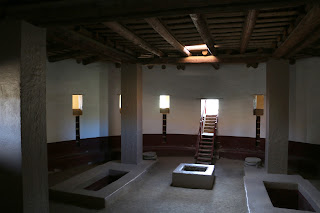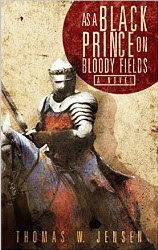Personal
letters are extraordinary things. Even just
a few lines written from one person to another centuries ago can immerse you in
his or her immediate needs, hopes, aspirations and, sometimes, terrors. This is the 28th episode of my peripatetic
exploration of the life, times and works of Sir Thomas Malory. Episode 1 can be found here.
In my last
post I discussed the dramatic event that concluded 1460: the death of Richard, Duke of York, at the
battle of Wakefield and his eldest son’s victory over Welsh Lancastrian forces
early the following year whilst King Henry was held under virtual house arrest at
the Palace of Westminster by the Earl of Warwick. One letter in the Paston collection makes
life in London and Norfolk at the time particularly visceral. It was sent to John Paston, a 40 year-old
Cambridge educated lawyer with property in Norfolk from his younger brother
Clement, a 19 year-old law student then at the Inns of Court in London. He writes with the news of three men lost or
killed at Wakefield and then advises his brother to muster both footmen and horsemen
because he has heard that the “further” lords, that is Queen Margaret’s army,
will arrive in London sooner than people expect. He then adds,
In this
cwntre every man is well wyllyng to goo with my Lords here, and I hope God xall
helpe hem, for the pepill in the northe robbe and styll, and ben apoyntyd to
pill all thys cwntre, and gyffe a way menys goods and lufflods in all the
sowthe cwntre, and that wyll ask a myscheffe.
No wonder
everyone in the capital was willing to go north with the lords in London,
particularly the Earl of Warwick. In a
few short weeks concerns over rights of royal inheritance had been supplanted
with more immediate and physical concerns for the safety of person and
property. Clement finishes by saying
that all this was “wrytyn … in haste, wan I was not well at hesse.” No doubt Sir Thomas Malory had heard the same
news and must have felt the same concern for his family and home in
Warwickshire.
Early in
February, Warwick left London, taking the king with him to march north to confront
Queen Margaret’s forces. There is no explicit
evidence telling us whether Malory accompanied Warwick but in light of Malory’s
lifelong loyalty to the earls of Warwick, his implicit personal danger and his willingness
to take action at difficult times, I consider it most probable that he
did. The two armies met at St.
Albans. Warwick was outflanked and unable
to properly marshal his forces for battle; he abandoned the field leaving the
frail and confused king sitting beneath a tree where he was found by the Queen’s
forces.
The abbot of
the Benedictine monastery wrote that St. Albans, which fell to the pillage and
rape of the northern army, had been invaded by rabid animals.
It’s no
surprise then that the commons of London took matters into their own hands,
barred the gates and refused the Queen’s forces entrance, fearing the same
fate. Negotiations failed and, as she
had neither the equipment nor discipline for a siege she returned north,
leaving only her army’s devastation behind.
Meanwhile, Edward, the Earl of March and what remained of Warwick’s
forces reunited in the Cotswolds then marched on to London, where Edward was
received as a savior. “Let us walk in a
new wineyard, and let us a gay garden in the month of March with this fair
white rose and herb, the Earl of March,” went one song written for the
occasion. At Baynard’s castle Edward
took counsel with his lords and decided to press his claim to the crown. In the Court of Chancery he was sworn before
the Archbishop of Canterbury, the Chancellor and the assembled lords that he
should truly and justly keep the realm and the laws thereof maintain as a true
and a just king. But he wasn’t
crowned. First, he would prove himself
on the field of battle.
During March both Edward, the Earl of March, and Queen Margaret sent out royal commissions
of array to increase their forces. According to Yorkist paymasters several years
later he may have raised as many as 48,000.
Margaret’s army may have had as many as 60,000. Contemporary logistical capability meant that
neither could maintain a force of that scale in the field for very long. Conflict was imminent.
The first
encounter took place on Saturday, March 28, at Ferrybridge in Yorkshire. Forward units of Edward’s army under the
Duke of Suffolk and Lord Fitzwalter were attempting to rebuild a broken bridge
across the Aire when they were set upon by a detachment of horsemen under “Bloody”
Lord Clifford. Edward reinforced, the
Lancanstrians fell back but were trapped:
in the meantime Edward had sent a second detachment of mounted archers under
Lord Fauconberg to cross the river three miles upstream. In the early evening they hunted Clifford and
his men down and slaughtered them all.
Clifford himself, was killed by an arrow through the throat. In light of Malory’s debt to Fauconberg and
his demonstrated ability for quick action it’s more than possible that he took
part in the action.
The great
battle took place the next day at Towton.
The ferocity, cruelty, desperation and losses remind me of the worst
battles of the American civil war, such as Shiloh and Antietam. Both armies ordered that no quarter was to be
given. Lancaster had the great benefit
of holding the heights and superior numbers.
Further, not all of the forces of the Earl of March had arrived: the Duke of Norfolk was missing.
But York had
the most important advantage: the
weather. Lord Fauconberg initiated the
battle with an archery exchange. The
strong winds from the south carried the Yorkist arrows into the Lancastrian
ranks while Lancaster’s arrows and artillery fell short. The battle lasted all day long and the
outcome remained in doubt until Norfolk finally arrived. Then the Lancastrian army collapsed. 28,000 men died in the fighting and the
ensuing rout. In some cases those
fleeing the battle last had the best chance of survival as they were able to
cross the rivers on the corpses of those who had died trying to cross
before. The rivers ran red for days. It must have seemed like Armageddon. It was Palm Sunday and so near the full moon.
This worst battle ever fought on English soil is echoed in Malory’s telling of the final conflict between Arthur and Mordred. In all of Malory’s sources, save one, Arthur’s and Mordred’s forces fight on horseback. In Le Morte d’Arthur they fight on foot as at Towton. The night after the battle the bodies are despoiled. Recent archaeological research at Towton confirms the theft and mutilation of the corpses at Towton.
We don’t know that Malory was there. We do know he was physically capable as he participated in the sieges at Alnwick and Bamburgh shortly after. Further, he was granted a new (and second) pardon for all previous offenses by the new king Edward IV in October of 1462, quite possibly as a result of service that terrible and apocalyptic day.
Episode 29 can be found here.
















